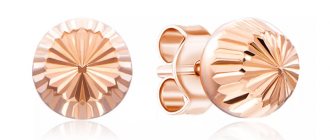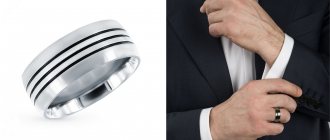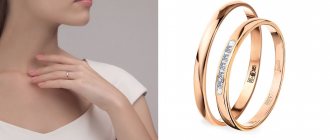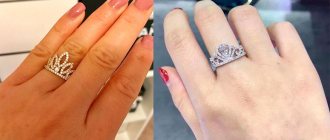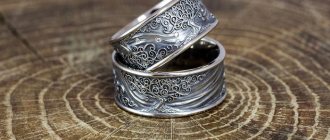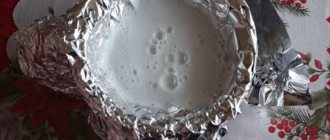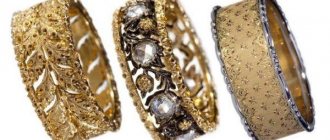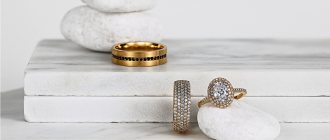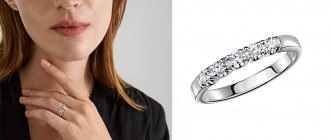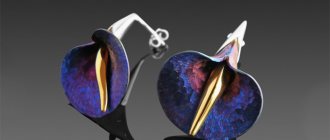Go to the online store
16.072020
Diamond engagement rings have a luxurious and expensive design that attracts the attention of many people. This decoration has a pronounced and rich shimmer even in the absence of inserts of precious or semi-precious stones. Depending on the couple, these wedding rings may have the same design or have elements that complement each other. Women's models look aesthetically pleasing and gentle, men's models look strict and laconic.
Key features and creation technology
Along with laser and hand engraving, diamond cutting is a common type of precious metal processing in jewelry. The design is applied to the surface of the product using diamond cutters, which give the metal its original shape. During the processing process, small cuts remain on the surface of the product, which create the effect of shimmering diamonds when the rays of the sun hit them. No other method allows you to create such a believable resemblance to the brilliance of diamond crystals.
The base of diamond cut engagement rings is most often made of platinum, yellow or white gold. The diamond edge also looks very impressive on rings made of combined metals. Often such jewelry is not complemented by stones, which could distract the eye from the skillfully created diamond path. Regardless of the presence or absence of a stone, a faceted engagement ring well emphasizes the taste of the owner.
Choose a product at the best price
Pick up
The principle of diamond cutting.
Cut affects three main characteristics of a diamond that determine how light interacts with the stone: brilliance, dispersion, and shimmer.
Luster is seen when light hitting the stone is reflected back. If the depth (or height) of the diamond is too high or too low, then the light entering it will not reflect back, creating shine, but will instead flow out of the stone, remaining invisible.
As a result, the brilliance of diamonds that are too deep or too shallow leaves much to be desired.
Dispersion is when the structure of a diamond breaks up when light hits the spectrum of colors. The result is seen as a play of colors when looking at the diamond, and is also called "fire".
Shimmer is the ability of a diamond to sparkle in intermittent flashes when you move it in front of your eyes.
A well-cut stone will show a lot of sparkle, while a poorly cut diamond will look much less vibrant.
Advantages and disadvantages
Products with a diamond cut have several advantages:
- Diamond processing can transform any piece of jewelry, no matter how spectacular it is or whether it has stone inserts.
- Possibility of preserving the original ring design. The surface becomes covered with scratches over time, but additional processing and the presence of a diamond edge will make them almost invisible.
- The pattern on the decoration does not fade or wear off for a long time, so the original design is preserved for a long time.
As for the disadvantages of products with a diamond edge, this is due to the fact that the product needs cleaning more often. Over time, the edges begin to polish, causing the diamond effect to become duller. But by turning to professionals, you can restore their original appearance.
Main characteristics.
The term "diamond cut" refers to the shape and appearance of the stone and the number and arrangement of its facets.
The main points that you need to pay attention to to determine the cut are the shape and edges.
- Form
Two different cuts may have a similar shape, but they will still be different.
For example, the emerald cut and the princess cut are both rectangular-shaped diamonds, but the difference lies in the configuration of the facets.
At the same time, the princess cut cannot be confused with a round cut, because they initially have different forms.
— Verges
The facets of a diamond play an important role in how the stone is able to reflect light and how brilliant it will be. Different cuts may even have the same number of facets, but they may be positioned differently.
Which is better: brilliant cuts or step cuts?
All existing types of cuts can be divided into two general groups - brilliant and stepped.
Shiny, as the name implies, is designed to increase the shine of the stone. The edges are formed and aimed at maximum refraction and reflection of the incident light. Round and princess are examples of brilliant cuts.
Stepped ones do not add shine to the stones. Their faces are formed in a linear manner, and the shape of the faces is arranged in a rectangular pattern. Emerald and Asscher are good examples of step cuts.
Options
Today, manufacturers offer a variety of original and unusual designs to choose from at a low cost of the product. Here are some diamond cut ring options:
- matte, smooth, with a sparkling rim;
- with brightly sparkling diamonds made of white or red gold;
- with a muted shine;
- with a dynamic and original pattern that creates impressive highlights.
Choose a product at the best price
Pick up
What is a perfect cut?
A diamond's ability to reflect light and exhibit brilliance depends on how it is cut, and more specifically, on the proportions of its various parts in relation to each other.
A perfect cut means that the diamond is sized to refract and reflect light in a way that maximizes sparkle and brilliance. On the other hand, the further the proportions of a diamond are from the dimensions considered ideal, the more light that enters the stone flows out of it.
Because the edges of poorly cut diamonds are not well aligned to retain maximum light, they appear dull and lifeless.
The ideal cut is a concept that is of utmost importance when deciding which diamond to buy. But what are the exact standards for the ideal, and what dimensions should a stone have to be close to it?
There are several widely used standards that define what an ideal cut should look like. However, the basic concept of each of these guides remains the same - the best cut should maximize the beauty of the diamond.
Is it worth buying and how to choose
A ring decorated with a diamond cut is a universal solution for any outfit. If we talk about purchasing such jewelry, then it all depends on the taste and preferences of the newlyweds. If you like this model, then definitely, you should buy it.
When choosing diamond-cut engagement rings, you need to take into account the design features. The artistic treatment of the ring can be different. In some cases, the ornament is abstract. Sometimes it resembles a floral design. Grooms most often prefer simple products. The presence of inserts and additional decor is undesirable. The diamond edge goes well with a laconic decoration. When choosing, consider the following recommendations:
- Decide on the metal from which the ring should be made. To do this, remember what metal products you wear most often in everyday life. This will help you make a choice, because... you will need to match them with your engagement ring.
- The width of the product largely depends on the physiological characteristics. Different finger lengths and hand shapes dictate their own rules. For example, almost any rings look good on thin fingers, but if the length of the hand is average, then it is better to exclude massive ones.
- Decide if you need a stone. For fans of simplicity, many stylish and beautiful solutions are offered without stones or with a minimal presence of them.
- It is better to give preference to paired options. They have a common idea, as a result of which the design of one product will correspond to the design of another. Today there are many unusual and original paired rings with diamond edges, so finding the optimal solution will not be difficult.
To ensure that the jewelry retains the shine of the design and the shine of the precious metal for many years, protect it from the negative effects of chemicals. It is better to remove it before doing homework, otherwise the ring may become scratched or deformed over time.
Features of diamond engagement rings
Gold rings look perfect with diamond cutting . Gold is initially considered a noble metal. For this reason, gold jewelry symbolizes a long and prosperous family life. If desired, you can make the decoration unique and unusual.
Photo of a fluted engagement ring with a diamond edge
The processing technique received the appropriate name, as it visually resembles diamond shine . For this, special cutters are used. They are used to cut metal. Then the desired drawing is created. Usually it represents geometric shapes. Sometimes jewelry is distinguished by smooth lines, curls, and floral patterns.
Typically, carved ribbed wedding rings require special skill from the jeweler. The performer must have developed artistic taste and know the specifics of working with precious metals. The result of the work is beautiful jewelry . As a result, the precious material shimmers in the sun.
It seems that real diamonds were actually used for its decoration.
look finished after diamond processing For this reason, you can refuse to use additional jewelry (for example, precious stones). The bride and groom can choose similar wedding rings. The relief and pattern will allow you to create rings in a similar style.
Diamond cutting is successfully used for different types of gold and platinum. Jewelry manufacturing technology is developing successfully. Gold becomes a worthy basis for creating high-quality jewelry. Diamond cutting allows you to make any product original. Rings with diamond coating or special chips look stylish. If desired, you can choose an elegant faceted engagement ring that will highlight the owner's taste in jewelry.
Large selection of jewelry in the showrooms of the Golden Gross Center
You can find wedding rings for men and women, as well as earrings, pendants, chains, brooches and other jewelry made of gold, platinum and silver here. On three floors of the Golden Gross shopping center there are about 120 stores, which present products from more than 750 manufacturers. Among the presented brands there are both Russian and foreign. Each of our partners is a reliable and trusted seller. Therefore, we give our own guarantee for each product purchased in one of our stores. Frequently held promotions in salons allow you to save on almost every purchase. Discounts on selected products reach 50%.
Also on the territory of Golden Gross there are jewelry workshops staffed by qualified specialists with extensive experience. They specialize in making jewelry of any complexity and providing services related to the repair of products. You can confidently turn to them if you need spraying, polishing, removing bumps or dirt stains.
It is especially worth noting the high level of service. Each store has polite and responsive consultants who are ready to help you understand the variety available and choose the best solutions for you. You can try on any jewelry - this is one of the most important advantages of visiting our shopping center. This way you can evaluate not only the size of the jewelry, but also how well it matches your outfit. We pay special attention to the comfort of our visitors. Especially for this purpose, there are cafes and recreation areas on the territory of the jewelry center, where everyone can relax after a long search for the necessary jewelry.
Certification scale: a short path to assessment.
You don't have to study all of the above measurements in detail for every stone you look at.
There are many variables considered when grading a cut, and the process can be very complex. However, you can easily see how close a stone's cut is to the ideal standard by looking at the diamond certificate and checking the cut grade.
The two most authoritative bodies that evaluate cut grades are AGS (American Gem Society) and GIA (Gemological Institute of America).
AGS use a range of grades from "ideal" to "poor", while GIA grades grades from "excellent" (the highest grade) to "poor" (the lowest grade).
The GIA (Gemological Institute of America) does all the work for you and, taking into account various standards for lengths and angles, it assigns a cut grade to each diamond it certifies.
If the diamond you're considering comes with a GIA grading report, look into it. The GIA assigns grades to cuts using the following categories: excellent, very good, good, fair and poor.
Other laboratories have different scales and grade names, but they all follow the same logic: the closer the dimensions of a particular cut are to a set of proportions considered ideal, the higher the grade assigned.
As a general rule, try to avoid poor cut grades, and if you buy anything below a good grade, you shouldn't expect too much from your diamond in terms of brilliance or sparkle. In general, anything rated "good" or above is an excellent choice.
However, don't forget that the way a stone is cut is one of the most important factors in determining its appearance, so paying a premium for a better cut can definitely be worth it.
Filigree
You've heard the word "filigree" and always associated it with the meaning of "particularly careful" and "attentive to detail." You are absolutely right.
Filigree is a jewelry technique that is used by experts to create patterns from thin silver or gold wire. Filigree patterns can be in the form of herringbones, ropes, weaving and other patterns. This jewelry work is done under a microscope.
The term "filigree" has Latin roots. It comes from the words filum - “thread” and granum - “grain”. There is also a native Russian analogue - filigree jewelry technology. This word comes from the Old Russian “s’kati”, which means “to twist” or “to twist”.
Filigree is found both in jewelry and in boxes, vases and even on the hilts of ancient swords.
If you see a similar pattern on a piece of jewelry, you know that it is filigree.
